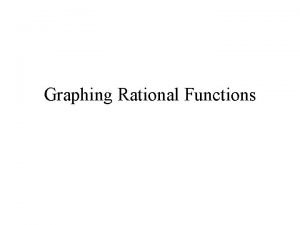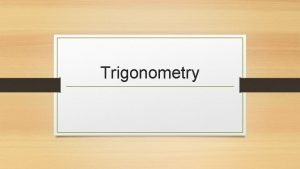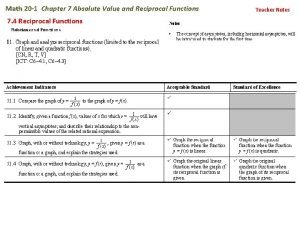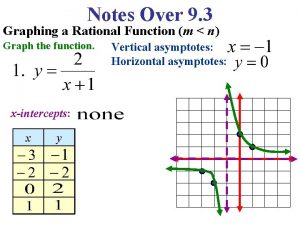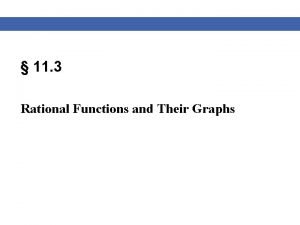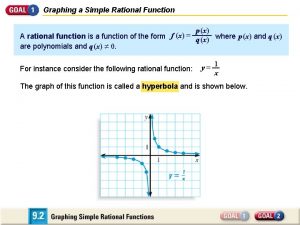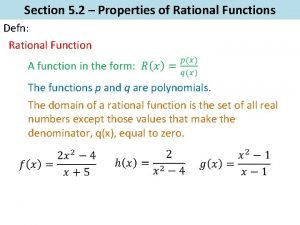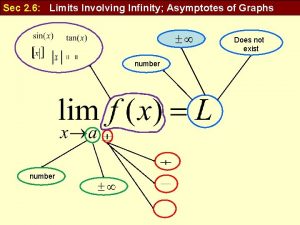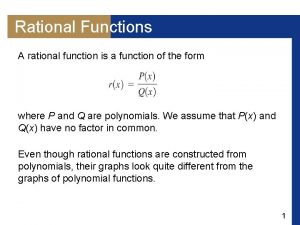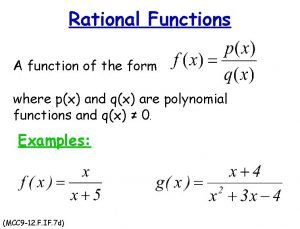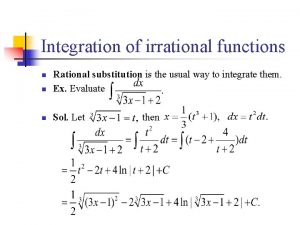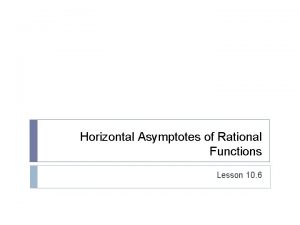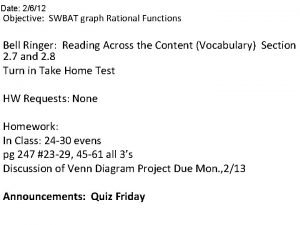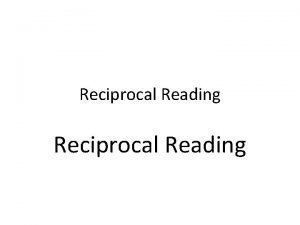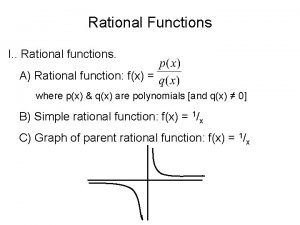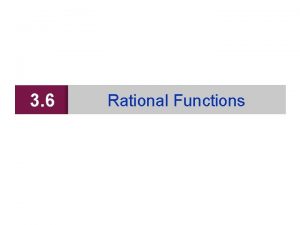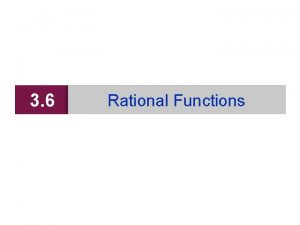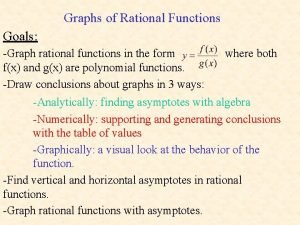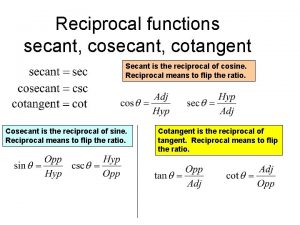You graphed reciprocal functions Graph rational functions with









































- Slides: 41


You graphed reciprocal functions. • Graph rational functions with vertical and horizontal asymptotes. • Graph rational functions with oblique asymptotes and point discontinuity.

• rational function • vertical asymptote • horizontal asymptote • oblique asymptote • point discontinuity


Graph with No Horizontal Asymptote Step 1 Find the zeros. x 3 = 0 x = 0 Set a(x) = 0. Take the cube root of each side. There is a zero at x = 0.

Graph with No Horizontal Asymptote Step 2 Draw the asymptotes. Find the vertical asymptote. x+1 = 0 x = – 1 Set b(x) = 0. Subtract 1 from each side. There is a vertical asymptote at x = – 1. The degree of the numerator is greater than the degree of the denominator. So, there is no horizontal asymptote.

Graph with No Horizontal Asymptote Step 3 Draw the graph. Use a table to find ordered pairs on the graph. Then connect the points.

Graph with No Horizontal Asymptote Answer:

Graph with No Horizontal Asymptote Answer:

A. B. C. D.

A. B. C. D.

Use Graphs of Rational Functions A. AVERAGE SPEED A boat traveled upstream at r 1 miles per hour. During the return trip to its original starting point, the boat traveled at r 2 miles per hour. The average speed for the entire trip R is given by the formula per hour. Draw the graph if r 2 = 15 miles

Use Graphs of Rational Functions Original equation r 2 = 15 Simplify. The vertical asymptote is r 1 = – 15. Graph the vertical asymptote and function. Notice the horizontal asymptote is R = 30.

Use Graphs of Rational Functions Answer:

Use Graphs of Rational Functions Answer:

Use Graphs of Rational Functions B. What is the R-intercept of the graph? Answer:

Use Graphs of Rational Functions B. What is the R-intercept of the graph? Answer: The R-intercept is 0.

Use Graphs of Rational Functions C. What domain and range values are meaningful in the context of the problem? Answer:

Use Graphs of Rational Functions C. What domain and range values are meaningful in the context of the problem? Answer: Values of r 1 greater than or equal to 0 and values of R between 0 and 30 are meaningful.

A. TRANSPORTATION A train travels at one velocity V 1 for a given amount of time t 1 and then another velocity V 2 for a different amount of time t 2. The average velocity is given by . Let t 1 be the independent variable and let V be the dependent variable. Which graph is represented if V 1 = 60 miles per hour, V 2 = 30 miles per hour, and t 2 = 1 hour?

A. B. C. D.

A. B. C. D.

B. What is the V-intercept of the graph? A. 30 B. 1 C. – 1 D. – 30

B. What is the V-intercept of the graph? A. 30 B. 1 C. – 1 D. – 30

C. What values of t 1 and V are meaningful in the context of the problem? A. t 1 is negative and V is between 30 and 60. B. t 1 is positive and V is between 30 and 60. C. t 1 is positive and V is is less than 60. D. t 1 and V are positive.

C. What values of t 1 and V are meaningful in the context of the problem? A. t 1 is negative and V is between 30 and 60. B. t 1 is positive and V is between 30 and 60. C. t 1 is positive and V is is less than 60. D. t 1 and V are positive.


Determine Oblique Asymptotes Graph Step 1 Find the zeros. x 2 = 0 x = 0 Set a(x) = 0. Take the square root of each side. There is a zero at x = 0.

Determine Oblique Asymptotes Step 2 Find the asymptotes. x+1 = 0 x = – 1 Set b(x) = 0. Subtract 1 from each side. There is a vertical asymptote at x = – 1. The degree of the numerator is greater than the degree of the denominator, so there is no horizontal asymptote. The difference between the degree of the numerator and the degree of the denominator is 1, so there is an oblique asymptote.

Determine Oblique Asymptotes Divide the numerator by the denominator to determine the equation of the oblique asymptote. – 1 (–) 1 The equation of the asymptote is the quotient excluding any remainder. Thus, the oblique asymptote is the line y = x – 1.

Determine Oblique Asymptotes Step 3 Answer: Draw the asymptotes, and then use a table of values to graph the function.

Determine Oblique Asymptotes Step 3 Answer: Draw the asymptotes, and then use a table of values to graph the function.

Graph A. B. C. D.

Graph A. B. C. D.


Graph with Point Discontinuity Graph Notice that the graph of with a hole at x = 2. . or x + 2. Therefore, is the graph of f(x) = x + 2

Graph with Point Discontinuity Answer:

Graph with Point Discontinuity Answer:

Which graph below is the graph of A. B. C. D. ?

Which graph below is the graph of A. B. C. D. ?

 Graph rational functions
Graph rational functions Graphing general rational functions
Graphing general rational functions Identify the graphed linear equation.
Identify the graphed linear equation. Carlos graphed the system of equations
Carlos graphed the system of equations Invariant points reciprocal functions
Invariant points reciprocal functions 8-5 solving rational equations and inequalities
8-5 solving rational equations and inequalities Zyntax
Zyntax Reciprocal trig functions
Reciprocal trig functions Reciprocal trig functions
Reciprocal trig functions Cubic and reciprocal graphs
Cubic and reciprocal graphs 8-2 practice the reciprocal function family
8-2 practice the reciprocal function family Reciprocal funtion
Reciprocal funtion Reciprocal in math
Reciprocal in math Arccos 2
Arccos 2 Rational graph
Rational graph Graphing rational functions
Graphing rational functions Sketch the graph of the following rational function
Sketch the graph of the following rational function Rational functions transformations
Rational functions transformations Real world rational functions
Real world rational functions Graphing rational numbers
Graphing rational numbers Line graph graph theory
Line graph graph theory Wait-for graph
Wait-for graph Horizontal and vertical asymptotes of rational functions
Horizontal and vertical asymptotes of rational functions Rational functions parent function
Rational functions parent function Unit 8 rational functions homework 1
Unit 8 rational functions homework 1 Rational expressions and functions
Rational expressions and functions Domain of function
Domain of function How to find a vertical asymptote
How to find a vertical asymptote Degree of denominator
Degree of denominator Range of rational functions
Range of rational functions Forms of rational functions
Forms of rational functions Radical functions and rational exponents practice
Radical functions and rational exponents practice Horizontal asymptote rule
Horizontal asymptote rule Irrational function example
Irrational function example Rational functions holes and asymptotes
Rational functions holes and asymptotes Gina wilson rational functions
Gina wilson rational functions End behavior of rational functions
End behavior of rational functions Removable and non removable discontinuities
Removable and non removable discontinuities Chapter 4 polynomial and rational functions
Chapter 4 polynomial and rational functions Chapter 3 polynomial and rational functions
Chapter 3 polynomial and rational functions Vertical asymptote rules
Vertical asymptote rules State the excluded values for each rational expression
State the excluded values for each rational expression
